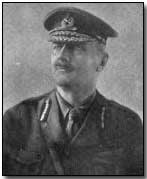Primary Documents - Gaston Bodart on the Fall of Turkey, September-November 1918
 Following the British
success in capturing Jerusalem in December 1917 further progress north was
effectively stalled in the face of strengthened German forces until
September 1918. In part this was because troops had been hastily
transferred to the Western Front in March 1918 to assist in the Allies'
defence against the German Spring offensive.
Following the British
success in capturing Jerusalem in December 1917 further progress north was
effectively stalled in the face of strengthened German forces until
September 1918. In part this was because troops had been hastily
transferred to the Western Front in March 1918 to assist in the Allies'
defence against the German Spring offensive.
Thus on 18 September Sir Edmund Allenby - British regional Commander-in-Chief launched the Battle of Megiddo at Rafat. This set in trail an unbroken series of victories including those at Damascus and Beirut (the latter seized by a French fleet). It was in light of these overwhelming victories that Turkey sued for an armistice of surrender, which was duly agreed on 30 October 1918 in Mudros. British forces subsequently took possession of Constantinople on 10 November 1918.
Reproduced below is an account of Turkey's fall by Germany's official observer, Gaston Bodart.
Click here to read a summary of Allenby's progress by W. T. Massey. Click here to read Allenby's official report on fighting at Megiddo. Click here to read a British eyewitness account of the surrender of the Gallipoli peninsular on 9 November; click here to read an account of the surrender of Constantinople on the following day by the official British observer G. Ward Price. Click here to read the proclamation of the newly appointed Sultan Mehmed VI in which he regretted Turkish crimes against the Armenians and promised a full investigation.
Gaston Bodart on Turkey's Fall
The long and at times obstinate conflicts in the valley of the Jordan gave Allenby time to complete the railway connections between Cairo and Jerusalem.
In order to have a word to say regarding the prospective conquest of Syria, France sent a fresh division to cooperate with Allenby's forces.
On September 18th, 1918, the great English-French attack on the Turkish lines between the Jordan and the sea began. It was flanked on the west by the artillery fire of the numerous warships, and to the east of the Hejaz Railroad by the rebellious Arab tribes under their new King Hussein.
The powerful and well-directed offensive, with its preponderance of numbers particularly as to cavalry, which was here of great service, met with complete success. On the first day the Turkish lines were already penetrated to a depth of eight kilometres.
The principal battle took place on the 19th between Rafat and the coast and led to the complete penetration of the Turkish lines. The Seventh and Eighth Turkish Corps were almost annihilated. On September 22nd the passage of the Jordan was forced, and on the 26th Nablus was occupied, the British cavalry relentlessly pursuing the enemy.
The ruins of the Turkish army retreated in part toward Tiberias, and in part over Aman toward Damascus, which was occupied on September 30th by an Australian cavalry division.
The French forces turned toward Beirut, which they occupied on October 6th. The Turkish reserves under Liman von Sanders, which had been hurriedly brought up, did not succeed in changing the turn of affairs, but succumbed to the general demoralization now pervading the Turkish army.
This was beyond a doubt the most complete victory of the Entente in the war, for it had resulted in the complete annihilation of the enemy who not only lost 70,000 men as prisoners, but his entire artillery as well, including the brave Austro-Hungarian batteries which held out to the last.
After the British had occupied Aleppo on October 26th, the Porte asked for an armistice, which was concluded at Mudros on October 30th, 1918.
Source: Source Records of the Great War, Vol. VI, ed. Charles F. Horne, National Alumni 1923
Around one million Indian troops served in WW1, of which some 100,000 were either killed or wounded.
- Did you know?
